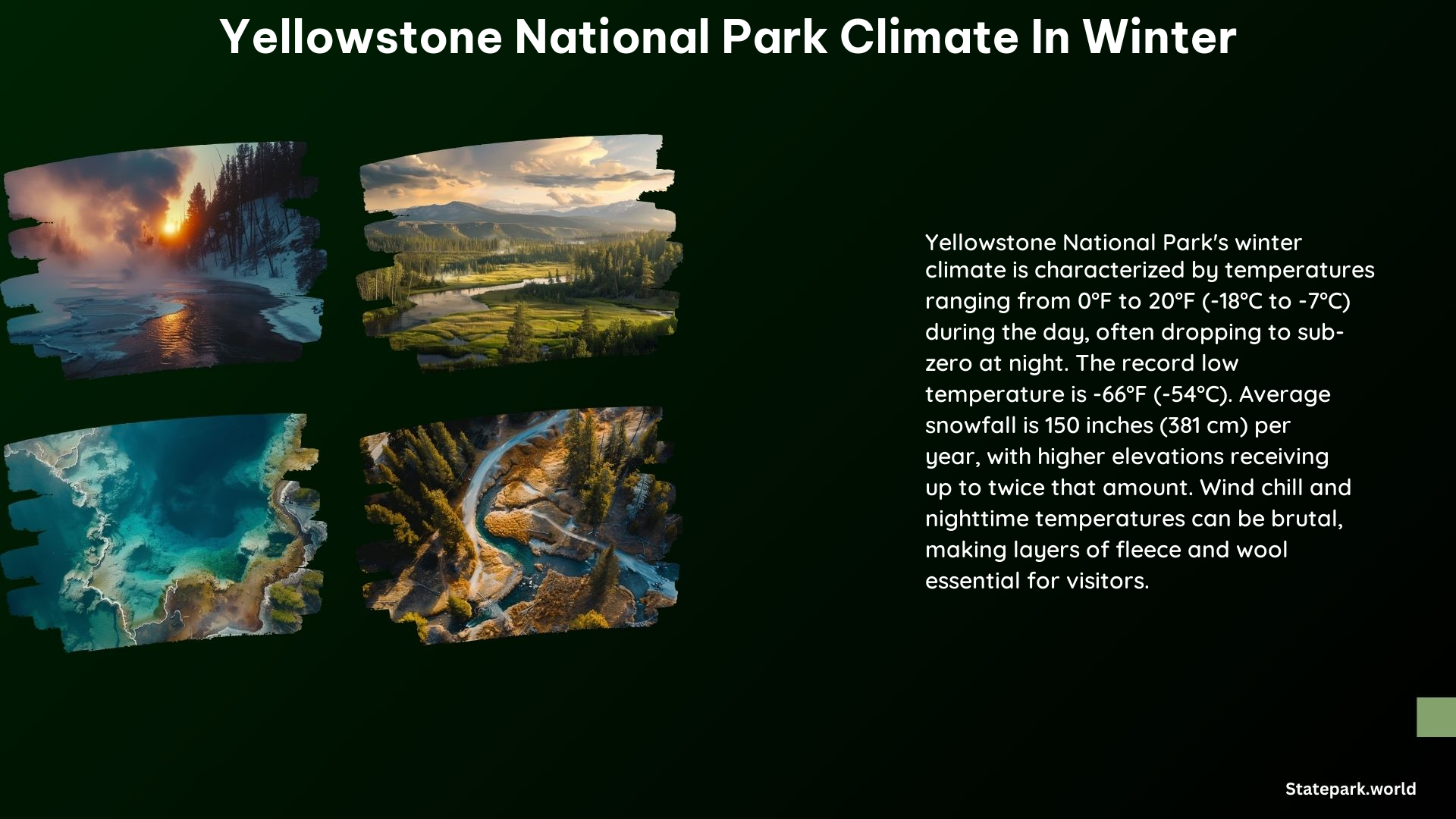Yellowstone National Park is a breathtaking natural wonder that attracts millions of visitors each year. However, the park’s winter climate can be harsh and unforgiving, with bitterly cold temperatures, heavy snowfall, and challenging conditions for those who venture into the park during the colder months. In this blog post, we’ll explore the details of Yellowstone’s winter climate and provide valuable information for those planning a winter visit to this iconic destination.
Average Temperature Range in Yellowstone National Park During Winter
Yellowstone National Park experiences extremely cold temperatures during the winter months. The average daytime temperatures typically range from 0°F to 20°F (-18°C to -7°C) throughout the day. However, the nighttime temperatures can plummet well below zero, with the record low temperature reaching a bone-chilling -66°F (-54°C).
The wind chill factor is also a significant consideration, as the strong winds can make the already frigid temperatures feel even more bitterly cold. Visitors to the park during the winter must be prepared for these extreme conditions and dress accordingly to stay warm and comfortable.
Snowfall in Yellowstone National Park

Yellowstone National Park is renowned for its heavy snowfall, and the winter months are no exception. On average, the park receives an impressive 150 inches (381 cm) of snow annually, with the majority of this accumulation occurring during the winter season.
The monthly snowfall patterns in Yellowstone are quite variable, with the heaviest snowfall typically occurring in December. In this month, the park can expect to receive an average of 72.1 inches (183.1 cm) of snow. The snowfall then tapers off in January and February, with average monthly accumulations of 14.5 inches (36.8 cm) and 10.4 inches (26.4 cm), respectively.
Other Winter Conditions in Yellowstone National Park
In addition to the extreme temperatures and heavy snowfall, Yellowstone National Park’s winter climate is characterized by other challenging conditions. The wind chill factor, for example, can make the already frigid temperatures feel even more bitterly cold, posing a significant risk of frostbite and hypothermia for unprepared visitors.
The park’s high elevation and rugged terrain also contribute to the harsh winter environment. Navigating the snow-covered trails and roads can be treacherous, and visitors must be prepared with the proper equipment and knowledge to safely explore the park during this time of year.
Visiting Yellowstone National Park in Winter
Despite the challenging winter climate, Yellowstone National Park remains a popular destination for those seeking a unique and unforgettable experience. However, visitors must be well-prepared and take the necessary precautions to ensure their safety and enjoyment.
Road Access
During the winter, only the road from Gardiner, Montana, to Cooke City, Montana, is open to private vehicles. All other roads and entrances to the park are closed and accessible only by over-snow transportation, such as snowmobiles or snowcoaches.
Accommodations
The Mammoth Hot Springs Hotel and the Old Faithful Snow Lodge are the only accommodations within the park that remain open during the winter months. The Old Faithful Snow Lodge, in particular, is only accessible by snowcoach, adding an extra layer of adventure to the winter visit.
Winter Activities
Yellowstone National Park offers a variety of winter activities for visitors, including skiing, snowshoeing, and wildlife watching. Guided tours and excursions are available, providing visitors with the opportunity to explore the park’s stunning landscapes and observe its diverse wildlife in their winter habitats.
Preparation
Visitors to Yellowstone National Park during the winter must be well-prepared for the harsh conditions. Proper clothing, including layers of fleece and wool, heavy-duty, water-resistant gloves, scarves, and boots, is essential. Sunscreen, lip balm, and hand and body lotions can also help counteract the dry air.
In conclusion, Yellowstone National Park’s winter climate is characterized by extremely cold temperatures, heavy snowfall, and other challenging conditions. While the park remains a popular destination during this time of year, visitors must be well-prepared and take the necessary precautions to ensure their safety and enjoyment. By understanding the park’s winter climate and planning accordingly, visitors can have an unforgettable and rewarding experience in this iconic natural wonder.
References:
– National Park Service. (2023). Weather – Yellowstone National Park. Retrieved from https://www.nps.gov/yell/planyourvisit/weather.htm
– Yellowstone Park. (2023). Yellowstone Weather by Season and Month. Retrieved from https://www.yellowstonepark.com/park/weather-seasons/average-yellowstone-weather-season/
– Natural Habitat Adventures. (n.d.). Weather & Climate: Winter Season | Yellowstone National Park. Retrieved from https://www.nathab.com/know-before-you-go/us-national-parks/yellowstone/weather-climate/winter-season/
– Yellowstone National Park Lodges. (2024). FAQ: Everything to Know About Visiting Yellowstone in Winter. Retrieved from https://www.yellowstonenationalparklodges.com/connect/yellowstone-hot-spot/faq-everything-you-need-to-know-about-visiting-yellowstone-in-winter/
– National Park Service. (2023). Explore in Winter – Yellowstone National Park. Retrieved from https://www.nps.gov/yell/planyourvisit/visiting-yellowstone-in-winter.htm
